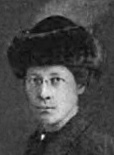Alda Heaton Wilson facts for kids
Alda Heaton Wilson (1873–1960) was a pioneering architect and civil engineer from Iowa. She and her sister, Elmina Wilson, were among the first American women to become civil engineers after earning a four-year college degree. Alda worked as an architect in several states before moving to New York.
She also became the first woman to lead the women's drafting department at the Iowa Highway Commission. Later in her life, she worked closely with Carrie Chapman Catt, a famous leader in the women's suffrage movement.
Contents
Her Early Life and Education
Alda Heaton Wilson was born on September 20, 1873, in Harper, Iowa. Her parents were Olive and John C. Wilson. She was the youngest of six children.
In 1894, Alda earned her bachelor's degree in civil engineering from Iowa State University (ISU). Her sister Elmina also graduated that same year with a master's degree in engineering. Both sisters were part of the Pi Beta Phi sorority. They strongly believed in education for women and supported the suffrage movement, which fought for women's right to vote.
Building a Career in Architecture
From 1895 to 1897, Alda worked for different architecture companies in Chicago. She then continued her studies at Massachusetts Institute of Technology (MIT) in 1897 and 1898. After MIT, she returned to Chicago and later worked in Kansas City and Ames, Iowa.
One of the companies Alda worked for was Patton & Miller. This firm was known for designing many Carnegie libraries across the United States. In 1903, Alda and Elmina took a break from work to study engineering and architecture in Europe.
When they returned in 1904, Alda worked as an independent architect for several well-known companies in New York City. The sisters traveled to Europe again in 1908 to study architecture in Spain and France. In 1913, they planned another trip to Germany, Italy, and Sicily.
In 1915, the sisters worked together on drawings for the Teachers Cottage, also known as Helmich House. This building was located in Gatlinburg, Tennessee, at the Arrowmont School of Arts and Crafts.
The Wilson sisters were also involved with the Manhattan Woman's Suffrage Club. Elmina was even the president of this club. Through their work, they met important leaders like Susan B. Anthony, Carrie Chapman Catt, and Eleanor Roosevelt. Because of their Iowa connections and their work for women's voting rights, the sisters became good friends with Carrie Chapman Catt.
A Special Friendship and Legacy
In 1918, Elmina passed away. Alda then returned to Iowa. In 1919, she started working as the head of the women's drafting department for the Iowa Highway Commission. This department was created because many men were away after World War I. The Highway Department needed skilled drafters, and women helped fill these important roles. Alda also continued her freelance design work during this time.
Alda left the Commission in 1921. She began spending more time traveling with Carrie Chapman Catt. She gradually did less of her own architectural work. In 1928, after Catt's close friend Mary Garrett Hay died, Alda moved in with Catt to help her. She became a permanent housemate and Catt's secretary.
After Carrie Chapman Catt died, Alda was in charge of her estate. Alda donated six albums of photos and materials about women's voting rights around the world. She had put these albums together as Catt's secretary. These important historical items went to Bryn Mawr College and the Library of Congress.
Alda Heaton Wilson died on July 25, 1960, in Chicago, Illinois.
Important Buildings She Helped Design
The Freed Residence
In 1909, Alda and Elmina worked together on the design of a house for W.J. Freed and his daughter Kittie. This house was a six-room cottage in Ames, Iowa. W.J. Freed was an early farmer in Story County, Iowa. Kittie was the librarian at the Ames Public Library and also an Iowa State University graduate.
The Helmich House
The Helmich House was designed in 1915. It was the first known building in Gatlinburg, Tennessee, to be designed by an architect. It was part of the Arrowmont School campus. This school project was supported by the Phi Beta Phi sorority.
The house was built in 1916. It had 10 rooms and was made to be living quarters for the teachers at the school. It had modern features for its time, including the first furnace in Gatlinburg and running water. The outside of the house had wood siding and a sloped roof.
In 2007, the Helmich House was added to the National Register of Historic Places. It is part of the Settlement School Community Outreach Historic District in Sevier County, Tennessee.
Images for kids
See also
 In Spanish: Alda Heaton Wilson para niños
In Spanish: Alda Heaton Wilson para niños



